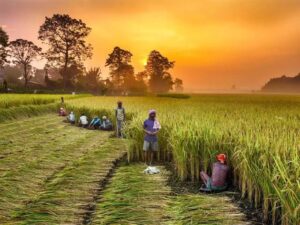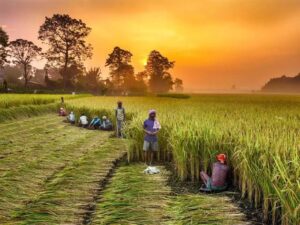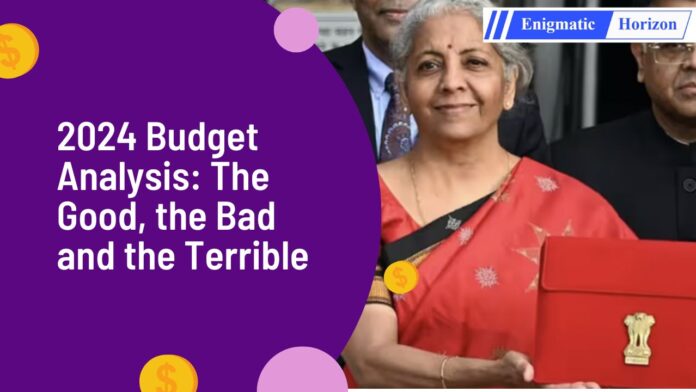Nupur Jha
On February 1, Union Finance Minister Nirmala Sitharaman presented the country’s budget for 2024-25. However, it’s an interim budget due to the upcoming Lok Sabha election. The new government will present the complete budget in July.
Even though it’s an interim budget and only for 2 or 4 months, it sets the tone for how PM Modi’s government will spend money, strategize for the country, and his plans to empower the nation on an international level.
According to the budget, the government plans to make India a developed country by 2027. Given the record, this highly ambitious idea is not entirely impossible. However, the budget has some drawbacks for the common people and affects several sectors.
Here are the key points highlighting the positive impacts and negative aspects of the budget.
Positive Aspects of The Budget
Focus On Four Areas: Women, Poor, Youth & Farmers
According to Sitharaman’s statement, the new budget aims to uplift four important pillars of the country: women, the poor, youth, and farmers.
The government has also designated these four areas as the highest priority in their current budget.
The budget emphasizes women’s healthcare, vaccines, and cervical cancer, addressing critical aspects while also striving to empower them through financial and self-help groups. However, it is also to be noted that the long-term impacts of the vaccines are yet to be seen.
Regarding youth, the government aims to enhance skills and establish medical colleges. Sitharaman referred to the year as a golden era for tech-savvy youth, as the budget allocates a corpus of Rs 1 lakh crore with 50 years of interest-free loans provided. This long-term financing will also offer low or nil interest rates.
The budget aims to construct an additional 2 crore houses for the poor in urban and rural areas. The initiative will help poor people get their own houses, which is good news. Not only that, but the announcement of making the policy available for the middle-class population will allow them to either build or buy their own houses.
In the agricultural sector, efforts are focused on doubling farmers’ income by increasing the value in the sector and boosting investment in post-harvest activities.

The Atma Nirbhar Oil Seed Abhiyan has also been introduced to promote mustard, sesame, sunflower, groundnut, and soybean oils among the population, directly benefiting farmers.
However, it remains to be seen whether these schemes will be implemented to its fullest.
Promoting Solar Energy Rooftops
Another positive impact that can be seen is the government taking initiative steps to promote solar energy, which is not just good for the environment but also the common people.
The government aims for 10 million households to install rooftop solar panels to enhance their energy efficiency.
With the help of this scheme, the common households can save up to Rs. 15,000 to Rs. 18,000 annually on electricity bills.
Improving Infrastructure Development
A significant focus of the 2024 budget is on enhancing India’s infrastructure. Over the past four years, infrastructure development has spurred economic growth and created more job opportunities.
As Sitharaman said, the initiative will also help increase job opportunities by making it easier for companies to start their setups in India and welcoming more industries to various sectors.
The allocated outlay for the upcoming year has been increased to 11.11 lakh crore, which amounts to 3.4% of GDP.
Enhancing Railway Transportation
FM announced the conversion of 40,000 normal bogies to meet Vande Bharat standards, aiming to enhance passenger convenience, comfort, and safety.
The budget also includes plans for three major railway corridors: port connectivity, energy and mineral, and cement. These initiatives are expected to increase travel speed and safety for passengers.
The 2024-25 railway allocation is much higher than the previous year’s Rs 2.41 crore. It has seen a significant increase of Rs 1 crore.

While it’s indeed good news, hopefully, the government will also focus on the ground level. The safety of railways has seen major incidents in the previous year, like the Andhra Pradesh train collision (29th October) and Bihar North East Express derailment (11th October). Especially, The Odisha incident (June 2023) was one of the nation’s most dangerous railway incidents, costing more than 260 people’s lives.
‘Lakhpati Didi’ Scheme for Women Empowerment
FM announced the ‘Lakhpati Didi’ scheme to empower women in rural areas socially and economically. The aim is to foster self-reliance through Self-Help Groups (SHGs) and benefit over 9 crore women.
The government has allocated Rs 83 lakh to improve the economic status of rural women. Additionally, the scheme is expected to stimulate the rural economy and increase credit demand for microfinance, focusing on women and SHGs.
Eliminating Middlemen
Nirmala Sitharaman highlighted in her speech that Direct Benefit Transfers (DBTs) through Jan Dhan accounts have transferred Rs 34 lakh crore directly to people’s accounts, saving Rs 2.7 lakh crore by eliminating leakages.
The budget focuses on cutting out middlemen and providing direct benefits to the people of India while reducing distribution losses.
Addressing Multidimensional Poverty
The new budget shifts focus to empowering people to escape multidimensional poverty. Traditionally, poverty has been measured based on income or expenditure levels. However, the Multidimensional Poverty Index (MPI) assesses poverty through 10 indicators covering health, education, and standard of living.
The PM Modi-led government presented a budget claiming that 25 crore people have been lifted from multidimensional poverty.
Negative Aspects of The Budget:
No Change in Taxation
For the common people, the budget brings no relief in taxation or changes in tax slabs. Taxpayers are required to pay according to the existing tax structure which is a major drawback of the 2024-25 budget.
Sitharaman stated that there would be no alterations in direct or indirect taxes, including import duties. This absence of change is perceived as negative, particularly for the common people of India, who anticipate tax benefits to cope with the ongoing high cost of living.
Budget Cuts in the Education Sector
The new budget also implements budget cuts in the education and literacy departments. According to Sitharaman, the education sector has been allocated Rs 1.20 lakh crore, which is 7.26% less than the previously allocated amount.

In last year’s budget, the government promised a budget of Rs 1.16 crore for education, but as per the revised budget, the spending amount is only Rs 1.08 crore. Since education is the basic need of our people, cutting the budget on such an important part might backfire for the government and the common people.
The government also cut UGC by 60%. This reduction will significantly impact higher education, particularly in the IIT and IIM sectors. However, the government has increased the budget for the research sector and central universities.
It’s Interim Budget
Since it’s an interim budget but not the complete one, it limits the scope of immediate impact. There are chances that several positive impacts might take effect after the new government gets elected. Also depending on the complete budget in July, it will delay the effectiveness and intended benefits of the policies.
